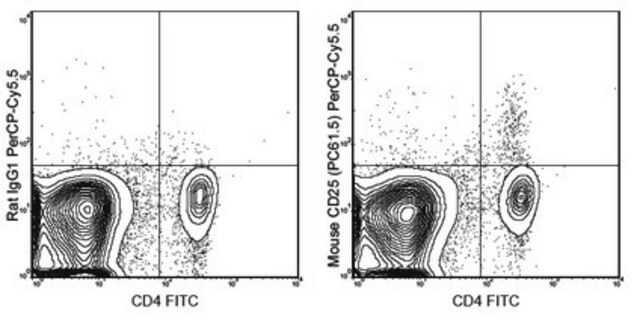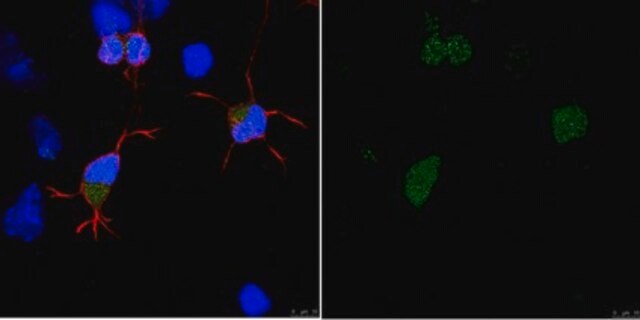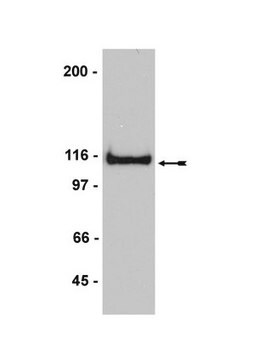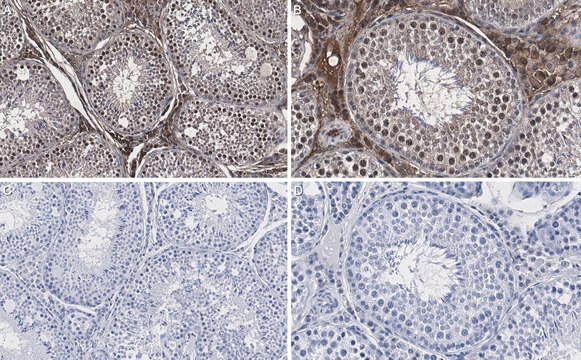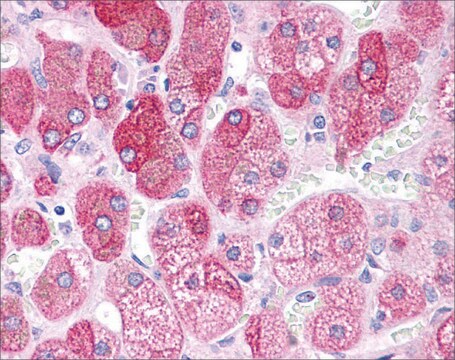MABN2297
Anti-APP Antibody, clone 7H6
clone 7H6, from rat
Sinónimos:
Amyloid beta A4 protein, ABPP, APPI, Alzheimer disease amyloid protein, Amyloid precursor protein, Beta-amyloid precursor protein, Cerebral vascular amyloid peptide, CVAP, PreA4, Protease nexin-II, PN-II
About This Item
Productos recomendados
biological source
rat
Quality Level
antibody form
purified antibody
antibody product type
primary antibodies
clone
7H6, monoclonal
species reactivity
human
technique(s)
ELISA: suitable
flow cytometry: suitable
immunocytochemistry: suitable
immunoprecipitation (IP): suitable
western blot: suitable
isotype
IgG1κ
NCBI accession no.
UniProt accession no.
shipped in
ambient
target post-translational modification
unmodified
Gene Information
human ... APP(351)
General description
Specificity
Immunogen
Application
Western Blotting Analysis: A representative lot detected APP in Western Blotting applications (Hoefling, C., et. al. (2016). Aging Cell. 15(5):953-63).
Flow Cytometry Analysis: A representative lot detected APP in Flow Cytometry applications (Hoefling, C., et. al. (2016). Aging Cell. 15(5):953-63).
Western Blotting Analysis: A 1:10 dilution from a representative lot detected App in WT and APP knockdown HEK293T cells (Courtesy of Dr. med. Peer-Hendrik Kuhn, Ph.D., Institut fur Allgemeine Pathologie und Pathologische Anatomie, Technische Universität München, Munich, Germany).
Immunoprecipitation Analysis: A representative lot detected APP in Immunoprecipitation applications (Hoefling, C., et. al. (2016). Aging Cell. 15(5):953-63).
ELISA Analysis: A representative lot detected APP in ELISA applications (Hoefling, C., et. al. (2016). Aging Cell. 15(5):953-63).
Immunocytochemistry Analysis: A 1:10 dilution from a representative lot detected APP in HEK293T either lentivirally transduced with APP shRNA-1 or APP shRNA-2 both coexpressing GFP as a reporter (Courtesy of Dr. med. Peer-Hendrik Kuhn, Ph.D., Institut fur Allgemeine Pathologie und Pathologische Anatomie, Technische Universität München, Munich, Germany).
Immunocytochemistry Analysis: A representative lot detected APP in Immunocytochemistry applications (Hoefling, C., et. al. (2016). Aging Cell. 15(5):953-63).
Neuroscience
Quality
Western Blotting Analysis: 1 µg/mL of this antibody detected APP in 10 µg of HEK293 cell lysate.
Target description
Physical form
Storage and Stability
Other Notes
Disclaimer
¿No encuentra el producto adecuado?
Pruebe nuestro Herramienta de selección de productos.
Optional
Storage Class
12 - Non Combustible Liquids
wgk_germany
WGK 1
Certificados de análisis (COA)
Busque Certificados de análisis (COA) introduciendo el número de lote del producto. Los números de lote se encuentran en la etiqueta del producto después de las palabras «Lot» o «Batch»
¿Ya tiene este producto?
Encuentre la documentación para los productos que ha comprado recientemente en la Biblioteca de documentos.
Nuestro equipo de científicos tiene experiencia en todas las áreas de investigación: Ciencias de la vida, Ciencia de los materiales, Síntesis química, Cromatografía, Analítica y muchas otras.
Póngase en contacto con el Servicio técnico
